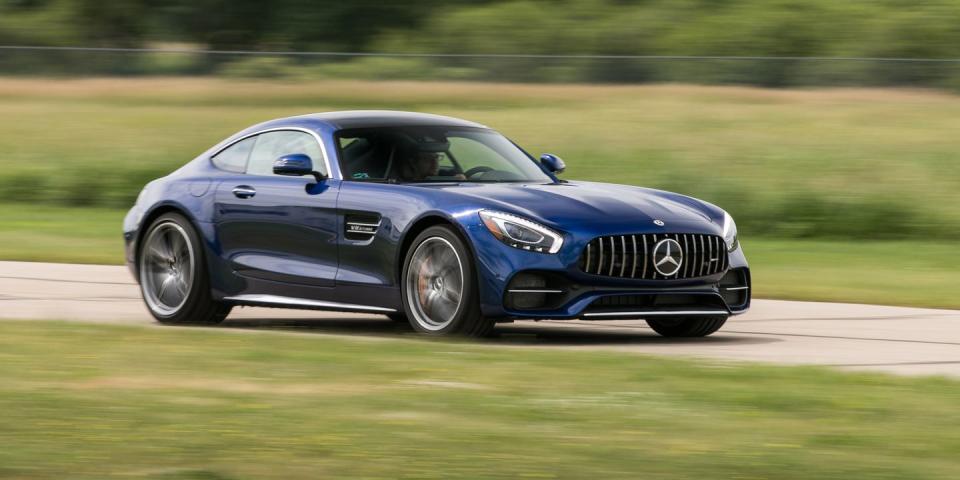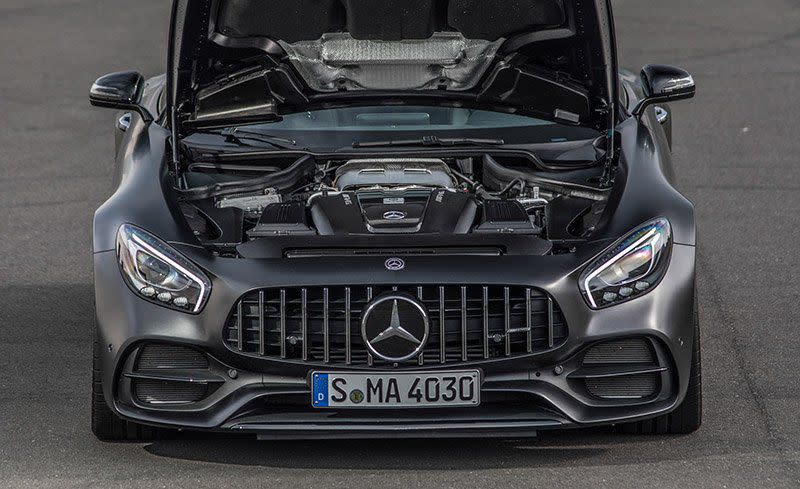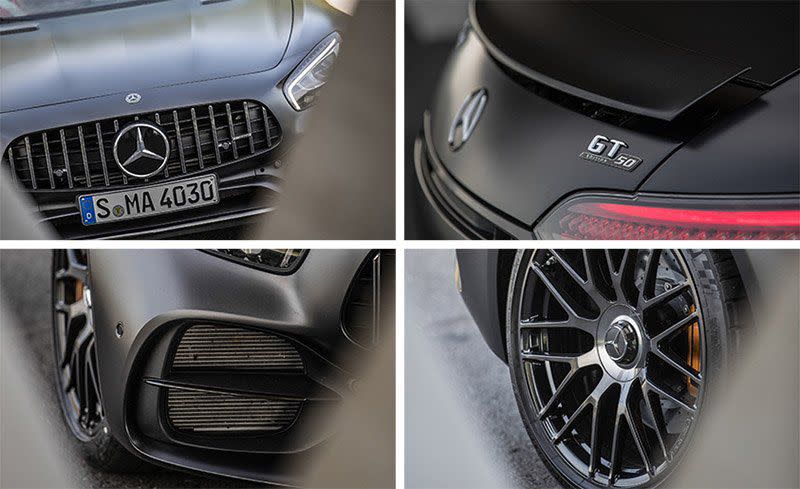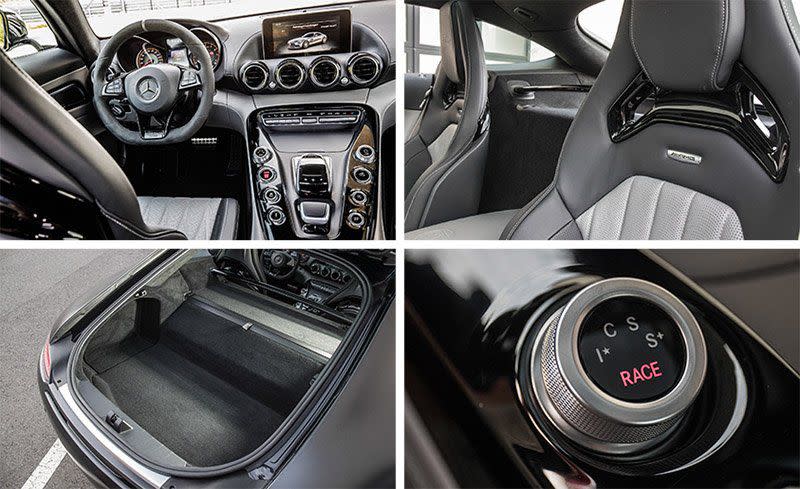2018 Mercedes-AMG GT C Coupe Offers Performance and Exclusivity

Think of the GT C that has been added to the Mercedes-AMG GT lineup as the equivalent of the Carrera GTS in the Porsche 911 roster. Both cars are the third step up on the power and expense ladder. Both come standard with distinctive interior and exterior design details. Both have fatter rear haunches to accommodate wider wheels and an increase in track compared with their lesser brethren. And both are topped by a track-oriented model further up the price and power scale-the GT R in the AMG's case and the GT3 for the Porsche.
Although AMG has copied the model structure that Porsche has successfully developed over more than 50 years of the 911, it does so with a completely different sort of car. The GT has its engine in the front rather than in the rear. That engine is a twin-turbocharged 4.0-liter V-8, not a twin-turbo 3.0-liter flat-six. And instead of the 911's clean and classic lines, the GT snaps and crackles with visual firepower.
While not an overtly retro design, the GT sports a rather lengthy hood by modern standards-one that recalls the 300SL from the 1950s. The same goes for the gaping new Mercedes grille inspired by the SLs that campaigned in the Carrera Panamericana, the legendary Mexican road race of the same era. With its beefy vertical bars that look like the teeth of some giant prehistoric catfish and the pie-sized three-pointed star centered in the opening, the grille dominates the appearance of this flamboyant car. The small, sleek greenhouse tacked onto the tail end of the body further emphasizes its muscular nature.
What Makes a C
In this latest C variant of the GT, that muscularity is enhanced from the rear view by an increase in overall width from 76.3 to 79.0 inches. The wider bodywork accommodates a rear track increase of 1.7 inches, as well as 12.0-inch-wide rear wheels with 305/30ZR-20 tires instead of the 11-inchers with 295/30ZR-20s on the S. This wider bodywork and track are shared with the street-legal GT R track special-which set the sixth-fastest time ever at our annual Lightning Lap showdown-although that model can come with even fatter rear tires.
The GT C's engine also has more in common with the GT R's than with the one in the base and S versions of the GT. Those two cars share a common turbo and intercooler package and have been uprated slightly for this year, with the base engine now developing 469 horsepower at 6000 rpm and 465 lb-ft of torque at 1700 rpm, while the S makes 515 ponies at 6250 and 494 lb-ft at 1800. The key difference is peak boost pressure-14.5 psi for the base engine and 16.0 for the S.
The slightly different version of the 4.0-liter V-8 in the C and the R is fitted with larger turbochargers to develop even higher boost pressure more efficiently. To help in this task, they employ freer-flowing exhaust ports, larger heat exchangers for the liquid-to-air intercoolers, and a reduced compression ratio-9.5:1 instead of 10.5:1 on the less powerful engines. Operating with a peak boost of 18.1 psi, the GT C engine produces 550 horsepower at 6250 rpm and 502 lb-ft at 1900 rpm. The R engine runs 19.6 psi to develop 577 horses and 516 lb-ft.
The seven-speed dual-clutch automatic transmission comes in two versions to match these engines. The lower-powered cars get a wider-ratio gearbox coupled to a 3.67:1 final drive, while the C and R transmissions have a higher first and a lower seventh gear attached to a 3.88:1 rear end. That produces an overall ratio spread that's about as close as that of the seven-speed dual-clutch in the 911 GT3. First gear is about 5 percent taller than in the standard AMG GT's gearbox, second through sixth are 5 percent shorter, and seventh is almost 14 percent shorter. The C and R models also get standard electronically controlled engine and transaxle mounts to provide a better combination of comfort and precision than can be achieved with conventional mounts.
Let's C How It Moves
Between the added power and the shorter gearing, the GT C is notably more energetic than the hardly slow base and S versions. Driving on the back roads of northern Germany near Bad Driburg, the C model leaps ahead when you squeeze the accelerator and kicks down less often than its brethren. Even if you put the gearbox in manual mode and leave it in top gear, there's still plenty of grunt. Throttle response is also prompt, with notably less turbo lag than in a modern 911 at low rpm.
Back home on our test track, we strapped our test gear to the GT C. Despite the wide rubber, we found the rear tires still struggled for purchase during launch-control starts. Ultimately, we achieved a 3.5-second zero-to-60-mph time and clobbered the quarter-mile in 11.5 seconds with a trap speed of 128 mph; staying on the throttle for an additional five seconds brings up the 150-mph mark. That's quick, but the GT C's arch nemesis, the Porsche 911 GTS PDK, rockets to 60 mph in 3.0 seconds and through the quarter in 11.3 seconds with a trap speed of 125 mph. As hinted at by its faster trap speed, the GT C begins to build serious steam as the speeds climb, beating the 911 to the 150 mph mark by 0.9 second.
Although these AMG GTs weigh several hundred pounds more than equivalent Porsches, they have a similarly responsive and lively character. Steering feel is excellent thanks to the electrohydraulic steering rack. The cars bend into corners securely and accurately, and the GT C comes standard with rear-wheel steering that provides even greater agility. Not only do the countersteering rear wheels help the C model cut harder at lower speeds, but the steering effort is a little lighter, making the car feel even more responsive. Above 62 mph, the rear wheels steer in the same direction as the fronts, enhancing stability in a straight line or a fast bend.
Overall handling is satisfying and inspires confidence. The GT C feels firmer than the base car, even in Comfort mode, which is appropriate since it has considerably more thrust. This is another car that has so much grip that it's hard to explore its limits on public roads, but you can proceed quite briskly without any sense that you are pushing the car's limits. At the test track, where we can push the GT C to the limits, it pulls 1.05 g of grip, matching the 911 GTS.
Brake feel from the optional carbon-ceramic rotors is excellent, with a firm pedal, easily modulated effort, and strong performance. They haul the GT C to a stop from 70 mph in just 150 feet. All AMG GT models come with hefty six-piston fixed calipers in front, and the carbon-ceramic front brake rotors measure 15.4 inches across, the same diameter as the GT C's standard iron rotors.
While you don't feel the GT C's 3741 pounds in hard driving, you are aware of the sheer size of the car. The GT C is less than two inches longer than a 911, but it's fully six inches wider than a Carrera GTS, let alone a base 911. On narrow European roads, that broad beam was noticeable.
Let's C Inside
Inside, the C model is essentially the same as other GT variants. The driving position is excellent, the instruments nicely arrayed, and the controls quite easy to use once you familiarize yourself with the car. The tiny shift lever looks wimpy, but the steering wheel has lovely paddle shifters that are a joy to use when you want to select gears yourself. The comfortable seats provide excellent lateral support. About the only thing missing is an adjustable thigh support, which is surprising as it's a feature offered in much less pricey machines.
Structurally, the GTs-coupe and roadster alike-feel rock solid, although German roads are smoother than the pavement one finds in most of the United States. Perhaps the smooth German pavement also explains why the cars generated such moderate tire noise despite being fitted with ultra-high-performance, low-profile rubber. Compared to a 911 GTS, a Corvette Grand Sport, or a Jaguar F-type SVR, the cabin-filling 76 decibels the GT C generates is one louder than the Jag and two quieter than the 911 or Vette. Not a huge advantage, but it's noticeable on a long drive, for sure.
Drivers can select among five driving modes-Individual, Comfort, Sport, Sport+, and Race-that adjust suspension stiffness, throttle response, shift programming, stability-control intervention, and exhaust sound. In Individual mode, you can personalize a setting of your own. For casual driving, for example, we rather enjoyed having the transmission in full manual mode, the exhaust spitting back under deceleration in the Sport+ mode, and the suspension and throttle response at their softest settings. This provided a satisfying combination of driver involvement and overall comfort. When left to shift automatically, the dual-clutch transaxle generally swaps cogs intelligently and smoothly, but there's an occasional slight lurch that you never experience with a Porsche dual-clutch.
The GT C coupe stickers for $146,995; the roadster version is $11K more. Those prices are more than $20,000 higher than the equivalent 911 Carrera GTS tariffs, but some of that difference reflects varying levels of standard equipment. For example, adding the automatic transmission and rear-wheel steering to the Porsche swells the sticker by more than $5000. Chalk up the rest to exclusivity. The 911 has been around for more than 50 years, and while the car doesn't sell in high volumes, Porsche sold more than 1000 of them in the United States in August alone. Meanwhile, Mercedes sold just over 800 GTs in the first eight months of the year.
Coupe or roadster, from the base car to the hotted-up R model, the AMG GTs are visually arresting, blindingly fast, and extraordinarily rewarding to drive. And, at least for now, they're even rarer than some Ferraris.
('You Might Also Like',)

 Yahoo Autos
Yahoo Autos 





